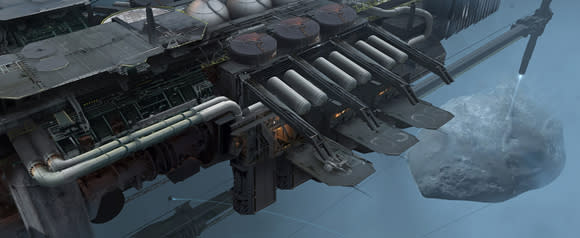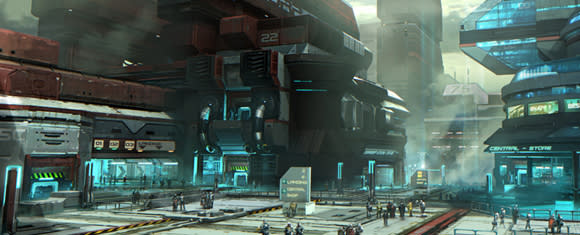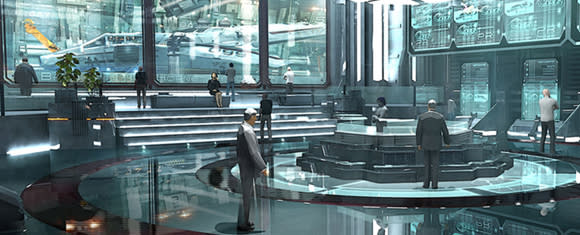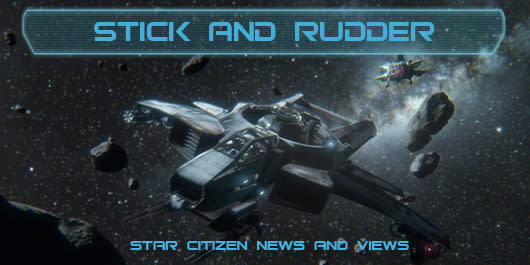Stick and Rudder: Getting perspective on Star Citizen's development
I recently spent a week enjoying the hell out of Elite: Dangerous. CCP's Valkyrie project -- a virtual reality EVE Online riff powered by Oculus -- is apparently far enough along to merit public demos and a slow-burning hype train. And Star Citizen? Well, I can still solo around in my hangar, fitting ship guns and firing them at cardboard targets.
I bring all this up not to pile on Cloud Imperium. On the contrary, I'm OK with SC's development pace, and if you're on the world side of the world-vs.-game debate, you should be OK with it too.


To casual Star Citizen fans, it may seem concerning that there are Elite alpha gameplay videos all over YouTube while they're still waiting on their first taste of SC's dogfighting module. Look deeper, though. Frontier and CIG do share plenty of similarities, from the fact that they're old school design companies with decades of game industry experience to the fact that they're working in the same newly resurgent genre on the same sort of newly resurgent sandbox space sim.
Sort of is the key phrase there, though. Elite is currently laser-focused on one thing, and while it's doing that one thing extremely well, what we know about Elite can't reasonably be compared to what's going on with Star Citizen. While Frontier has hinted at extra-vehicular activities, said activities are little more than rumor at this point, whereas Star Citizen has an entire arm of its 212-person dev team dedicated to humanoid first-person combat, both planetside and aboard starships, space stations, and the like.
Based on my experience with Elite's alpha and months of studying CIG's Star Citizen footage, it's also an apples-to-oranges comparison when you consider the aesthetics of both games, not to mention the sheer number of moving parts involved in a single Star Citizen spaceship. That's not to disparage Elite, either, as it's fun, it's gorgeous, and I will absolutely be buying and playing it on day one of its release.
But Star Citizen is simply on another level, both in terms of stated design goals and visual fidelity. In a perfect world, space sim fans would play and appreciate both games for what they are, but it's only natural to compare and contrast. And if you spend more than five minutes on the Star Citizen forums, it's impossible to miss some of the short-sighted sentiments and angry rants about CIG's development pace.


Chairman Chris Roberts even went so far as to introduce a new monthly studio update, the first entry of which was a titanic post filled with a ton of information as to what exactly each CIG office is currently doing. While I appreciated the info dump, I also rolled my eyes at the perceived need for it, since as Roberts mentioned, CIG currently delivers three dedicated video news shows per week alongside an active developer forum that fields community questions on a daily basis.
"I don't believe there is any other game, even one that is out of development and live, that involves and informs the community to the extent we do," Roberts wrote. And he's 100 percent correct. I've been gaming for over 30 years and following the industry for more than 20, and there has never been a more transparent triple-A project than Star Citizen.
Ever.
And depending on how SC ultimately works out, there may never be another one, either! CIG is going to great lengths to reward backers with access, behind-the-scenes info, and other niceties, and if the result is a bunch of entitlement-style whining, there's little incentive for other development firms to follow suit.


On some level I sympathize with impatient people in terms of getting my hands on a playable piece of Star Citizen content. No one's more excited for April's post-PAX DFM release than I am, but I'll also understand completely if it gets pushed back again. It's a matter of perspective, and it comes from grokking what Star Citizen is relative to what could (only generously) be called its competition.
Let's look at one of 2014's MMO big kahunas in order to gain some perspective on development cycles. The Elder Scrolls Online is the very definition of a big-budget triple-A release. It's not a space sim, naturally, but in terms of hype and current name recognition, I don't think it's a stretch to compare Star Citizen with ESO.

If early reports are accurate, though, ESO is certainly not a sandbox or an economy-driven virtual world of the type that Star Citizen aims to be. It's largely a linear, quest-based themepark capped off with a three-realm PvP endgame. And despite the fact that it's based on one of the world's most popular IPs and so has presumably had a lot of money and manpower thrown at it, it has taken seven years to make.
Seven years! To make what many beta participants are calling yet-another-themepark-iteration.
Consider that Star Citizen was announced in October of 2012. Also consider that it's now a year-and-a-half later. Are people really expecting a game that has self-identified as a sandbox virtual world -- you know, one of those titles that's infinitely harder to develop than a linear quest-grinder or a PvP lobby -- to hit every one of its pre-alpha milestones? And are they really surprised when a game that is pushing the visual and gameplay envelope far beyond any previous title needs to delay its first big module release?
Frankly it floors me that CIG is both a) close to putting the DFM in backers' hands and b) even willing to do it given the nature of the internet and the ill-informed criticism that powers it. I suspect that years from now we'll look back on Star Citizen's gestation and wonder how in the world CIG managed to keep it all together while at the same time creating its opus in the most public way possible. Game development is an inexact science and an iterative process in the best of times, so I can't imagine doing it in this sort of fishbowl.
And again, it's not as if Star Citizen backers are starving for information. The subscriber-only Jump Point magazine is an 80-page monthly delight, and as I mentioned previously, there's more freely available video and forum content than casual fans have time to consume. Not only that, but just last week CIG patched the hangar client to include Oculus Rift functionality! So yep, you can now toodle around your ships in full VR if you've got the goggles.
It was great to see the new monthly update initiative. But I hope Roberts and CIG don't get too caught up in listening to community complaints regarding a perceived lack of info or slower-than-desired development times. Star Citizen is gunning for virtual world status, and that's worth waiting for regardless of how long it takes.


Whether it's interviews with Chris Roberts and the Cloud Imperium team or tips and guides for pushing your ship's performance envelope, Stick and Rudder is your inside source for news and commentary on the world of Star Citizen. Join Jef Reahard every other Sunday during the run-up to alpha, beta, and beyond.



